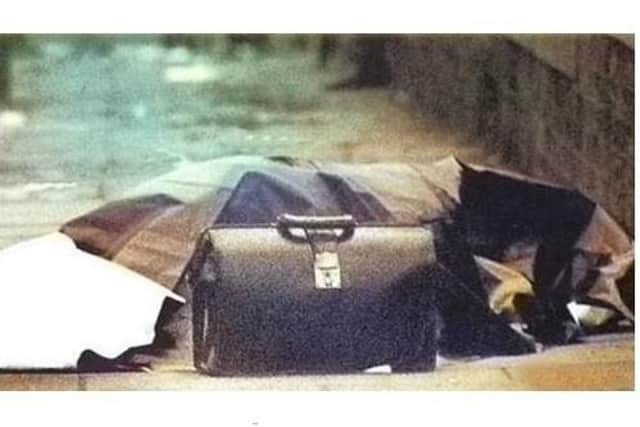Ben Lowry: The murder of Edgar Graham was a bid to terrorise unionists out of politics and it worked


(Click here for Ben Lowry article on the shortest evenings, which actually happen before the solstice)
Politicians including the former Alliance Party leader John Cushnahan, who grew up on the Falls Road and has been a bitter critic of the IRA since the 1960s, paid tribute to Mr Graham, who was an academic and a barrister. He was also an Ulster Unionist assembly member.
Advertisement
Hide AdAdvertisement
Hide AdThe UUP held an event in his memory at Stormont. And on pages 14 and 15, Dean Godson – the think-tank leader and biographer of the late David Trimble – writes about the murder of Mr Graham, who worked alongside Mr Trimble both as a legal academic and in the UUP.
The distressing picture on this page of the aftermath of Mr Graham’s murder by the IRA on University Square is a telling one. Queen’s University Belfast has a wonderful main Lanyon Building, and inner courtyard, almost a classic setting of learning akin to an Oxbridge college. When I was at school I savoured going to the Queen’s Film Theatre, which is on University Square, and which showed some of the finest movies. In sixth form, in the late 1980s, I used the QUB library on occasion, at the same location, opposite the film theatre.
Edgar Graham’s murder shattered any idea that QUB could be like an English campus environment, yet I was unaware of it at school, despite being interested in politics from the age of 12. The reason not is that he was slain on December 7 1983, when I was still 11 and not paying attention to particular Troubles killings.
Mr Graham’s murder properly came on to my radar in Easter 1992, when, aged 20, I was flying home from university in England for the holidays. I was sitting beside a woman from Northern Ireland who had become a headmistress on the mainland. We got talking about politics and about having lived on both sides of the Irish Sea. By then I was vaguely aware of Mr Graham’s killing. If I remember the conversation correctly, this woman said that her two sons had wanted to go to Oxford or Cambridge and become barristers, as Mr Graham did (after Oxford), and then return to politics in Northern Ireland.
Advertisement
Hide AdAdvertisement
Hide AdOne thing I recall clearly is that this woman said that the “IRA didn’t like what he [Edgar] had to say,” and her sons lost interest in NI politics and settled in Great Britain (If my description of this woman rings bells with anyone reading this article, please tell her to get in touch).
Her story embedded deeply in me. I had long known the IRA was unpleasant (most people thought so, with around 90% of voters rejecting Sinn Fein in the 1980s and 90s). But from that encounter I had a better understanding of the truest meaning of the word terrorism.
It is often said that Edgar Graham was murdered because he was the most talented of a young generation of unionists, and that is a very plausible claim. But I think it was not just an attempt to remove a specific political opponent, but a wider bid to scare unionists out of public life. And I think it worked, and is indeed a reason why Northern Ireland has suffered from poor governance.
There are, of course, and have always been politicians who are talented or brave or both. The three main unionist parties are led by two men who put on uniform to serve their nation and a man who is gifted KC. But there are many unionist politicians who are not so impressive. The IRA sent out a brutal signal that dark day in December 1983.
Advertisement
Hide AdAdvertisement
Hide AdAnd the IRA was very adept at instilling terror. With all the endless talk about collusion, and all the lavishly funded (by Britain) and grossly lopsided legacy investigations into historic claims against the security forces who prevented civil war, who would have any grasp of the Troubles statistics for Fermanagh for example? Of 116 people killed in the county, 100 were killed by republican terrorists (99 of those the IRA). Five were killed by loyalists, five by the army, one by the UDR, one by the RUC, one a terrorist by their own device, and three died of other causes such as drowning.
Fermanagh is a story of republican terrorising of the minority Protestant population, with the aim of ethnic cleansing (which failed). Far from there being collusion, state brutality etc there was almost no retaliation. A one-sided onslaught, met with massive restraint.
Edgar Graham’s sister wrote for us on the 40th anniversary of her brother’s heinous murder (the web version of this article will link to it). While some high profile Troubles killings or batches of killings, almost all of them victims of loyalism or UK state forces, have had millions spent on them in legacy probes, Ms Graham did not even get an investigation by the now disbanded Historical Enquiries Team (HET). Instead she got a letter saying there was no new evidence.
I have little confidence, I am afraid, that the emerging legacy body will shed much light on by far the largest category of Troubles dead – the 2,100 people killed by the republican murder machine.
• Ben Lowry (@BenLowry2) is News Letter editor